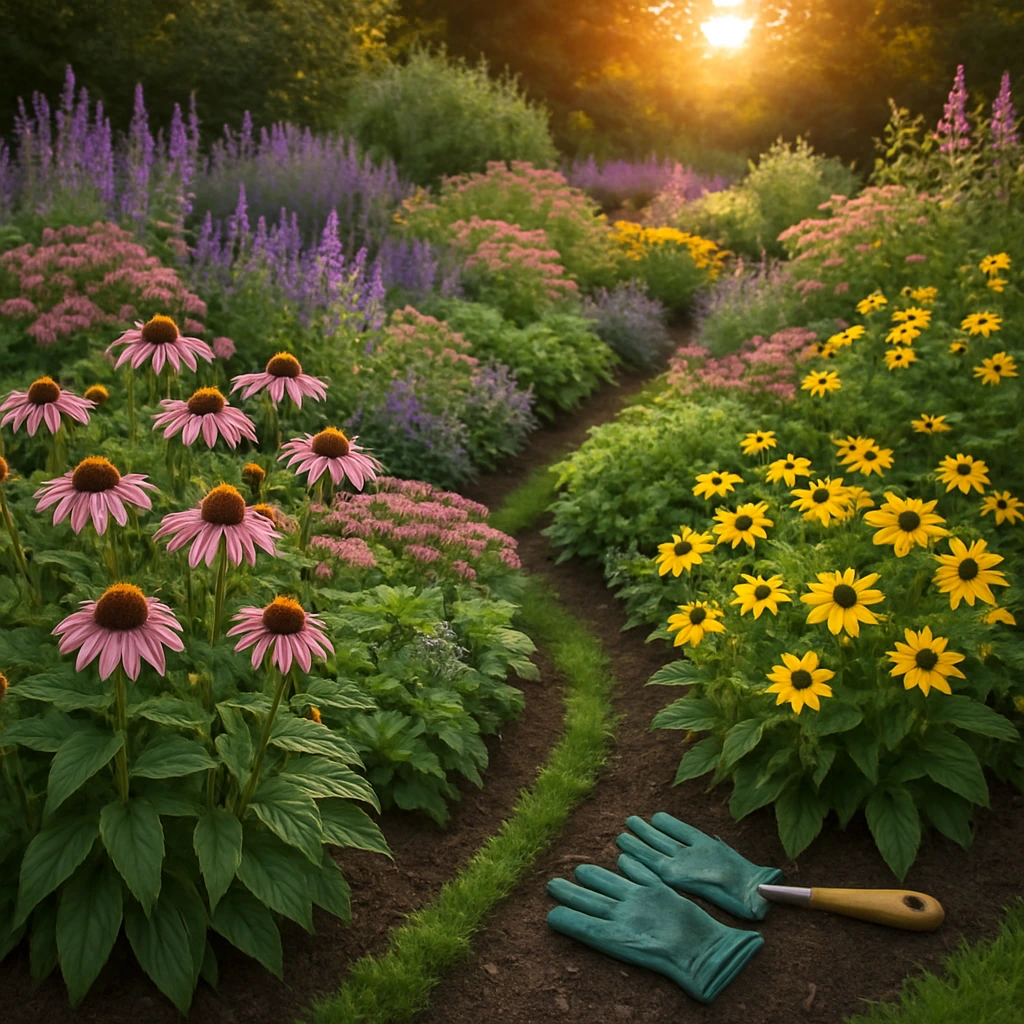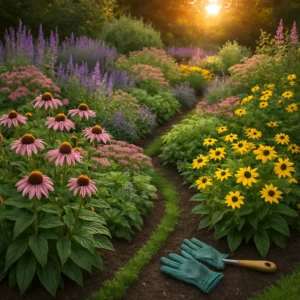The gardening 3-year rule is a practical guideline that suggests you avoid planting the same type of plant in the exact same spot in your garden for more than three consecutive years.
This simple practice helps protect your soil, reduce disease risks, and keep your plants thriving.
If you’ve ever noticed that your tomatoes don’t taste as good or your flowers aren’t as vibrant after a few seasons in the same patch of earth, this could be why.
In this post, we’ll break down how the gardening 3-year rule works, why it matters, and how you can easily apply it in your own garden—without needing a horticulture degree.
You have just planted a gorgeous perennial garden, complete with purple coneflowers, black-eyed Susans, and wild blue indigo.
You water them faithfully, feed them regularly, and wait for that Instagram-worthy garden explosion.
But by the end of the first season, you are left wondering if you have somehow failed as a gardener.
Your plants look… well, underwhelming.
Before you start questioning your green thumb credentials, let me introduce you to one of gardening’s most important yet often overlooked principles: the gardening 3-year rule.
This age-old wisdom, beautifully captured in the phrase “sleep, creep, and leap,” explains why patience isn’t just a virtue in gardening—it’s absolutely essential.
Also Read: top vertical garden ideas for small spaces
What Exactly Is the Gardening 3-Year Rule?
The gardening 3-year rule suggests giving a plant—or even an entire garden bed—three full growing seasons to truly settle in and show its potential.
This timeframe allows for root development, adaptation to the environment, and natural progression in growth and bloom cycles.
The rule is often expressed through a memorable rhyme that captures each year’s character:
- First year: Sleep – Plants focus on root establishment
- Second year: Creep – Modest above-ground growth begins
- Third year: Leap – Full potential is finally realized

Some gardeners know a slightly different version: “The first year they weep, the second year they creep, and the third year they leap.”
Both versions convey the same essential truth about plant establishment and the importance of patience in gardening.
The Science Behind the Gardening 3-Year Rule
Understanding why plants follow this three-year pattern requires a look at what’s happening both above and below ground.
When you transplant a perennial from a nursery pot into your garden, you’re essentially asking it to rebuild its entire support system from scratch.
Year One: The Sleeping Phase

During the first year, newly planted perennials are primarily focused on survival and root establishment.
Even though they may have looked robust in their nursery containers, their root systems have been living in artificial conditions—confined spaces with regular feeding and watering schedules.
Once planted, these roots need to explore their new environment, adapt to different soil conditions, and establish the extensive network needed to support future growth.
This process requires enormous energy, leaving little resources for spectacular above-ground displays.
Think of it like moving to a new city.
In your first year, you’re focused on finding your way around, establishing routines, and getting comfortable with your surroundings.
You are not throwing elaborate dinner parties yet—you’re just trying to figure out where the good grocery store is.
Year Two: The Creeping Phase

By the second growing season, plants have had time to develop stronger root systems.
They’re no longer in pure survival mode and can begin to invest energy in modest above-ground growth.
You will typically see improved foliage and perhaps some flowering, though not at the plant’s full potential.
This is the year when many gardeners start to see encouraging signs.
The plant looks healthier, maybe a bit larger, and shows more confidence in its new home.
It’s like that second year in a new city when you’ve found your favorite coffee shop and finally joined a local club.
Year Three: The Leaping Phase

The third year is when the magic happens. With well-established root systems that can fully support above-ground growth, plants finally start reaching their mature size and blooming potential.
This is when you’ll see the lush displays and abundant flowers that drew you to the plant in the first place.
Not All Plants Follow the Same Timeline

While the 3-year rule provides a helpful framework, it’s important to note that different species have varying timelines.
Some plants, like black-eyed Susan (Rudbeckia hirta), commonly flower their first year even though they are perennials.
Others, like purple coneflower (Echinacea purpurea), typically bloom in their second year.
Still others, like wild blue indigo (Baptisia australis), frequently take 3-4 years to reach their full potential.
Here’s a comparison of how different popular perennials typically progress:
| Plant | First Year | Second Year | Third Year | Special Notes |
|---|---|---|---|---|
| Black-eyed Susan | Often flowers | Full blooming | Peak performance | Fast establisher |
| Purple Coneflower | Foliage focus | First blooms | Abundant flowers | Moderate pace |
| Wild Blue Indigo | Minimal growth | Slow expansion | First major blooms | Very slow starter |
| Hosta | Basic foliage | Larger leaves | Full size/flowers | Steady progression |
| Daylily | Some blooms | Good display | Peak flowering | Relatively quick |
| Peony | Little growth | Small shoots | First blooms | Can take 3-5 years |
Why the Gardening 3-Year Rule Matters for Garden Planning
Understanding this timeline has practical implications that go far beyond managing your expectations.
It fundamentally changes how you approach garden design, plant selection, and maintenance strategies.
Managing Expectations and Avoiding Disappointment
The biggest benefit of knowing about the 3-year rule is psychological.
When you plant a new perennial border and it looks sparse in year one, you won’t panic or assume something’s wrong.
Instead, you will recognize this as normal plant behavior and resist the urge to dig everything up and start over.
This knowledge also helps you communicate more effectively with family members or neighbors who might question your gardening choices.
When someone asks why your expensive new plants look so small, you can confidently explain that you’re building a garden for the long term, not just the next season.
Strategic Plant Placement and Spacing
Knowing that plants will eventually reach their full size helps you avoid one of the most common mistakes in perennial gardening: planting too closely.
It’s tempting to space plants based on their current nursery size, but this leads to overcrowding problems in years two and three.
Instead, research the mature size of each plant and space accordingly.
Yes, your garden will look sparse initially, but you can fill the gaps with annuals or temporary plantings while your perennials establish themselves.
Budget Planning and Plant Investment
The 3-year rule also influences how you should think about plant purchases.
While it might be tempting to buy the largest, most expensive specimens available, smaller plants often establish more successfully and catch up to larger plants within the three-year timeframe.
This means you can often achieve the same results with smaller, less expensive plants if you’re willing to wait.
The money saved can be invested in better soil preparation, quality mulch, or a more diverse plant selection.
Exceptions to the Rule: When Plants Don’t Follow the Script
Like all gardening wisdom, the 3-year rule is not absolute.
Several factors can accelerate or delay the typical timeline, and recognizing these exceptions helps you make better decisions about your garden.
Fast-Track Plants
Some plants naturally establish more quickly than others.
Annual flowers, by definition, complete their entire life cycle in one season.
Many herbs, particularly Mediterranean varieties like lavender and rosemary, can look quite established by their second year if given proper conditions.
Certain perennials are also naturally fast growers.
Ornamental grasses, for example, often provide impressive displays in their second year, while plants like bee balm (Monarda) and catmint (Nepeta) can spread enthusiastically once they get going.

Slow-Motion Growers
On the flip side, some plants take longer than three years to truly shine.
Tree peonies, for instance, can take 5-7 years to reach their flowering potential.
Many native plants, particularly deep-rooted prairie species, invest heavily in underground development and may take 4-5 years to show their best above-ground performance.
Large shrubs and trees operate on an even longer timeline.
The saying “The best time to plant a tree was 20 years ago; the second best time is now” reflects the reality that woody plants require significant time investment to reach maturity.
Environmental Factors That Influence Timeline
Growing conditions can significantly impact how quickly plants establish.
Plants grown in ideal conditions—proper soil preparation, adequate water, appropriate light levels—often progress more quickly through the sleep-creep-leap cycle.
Conversely, challenging conditions can extend the establishment period.
Plants struggling with poor drainage, compacted soil, or inappropriate light levels may take longer to move through each phase.
In extreme cases, they may never progress beyond the “creep” stage.
Making the Gardening 3-Year Rule Work for You

Understanding the 3-year rule is one thing; applying it effectively is another.
Here are specific strategies to help you work with, rather than against, this natural timeline.
Year-One Strategies
During the first year, focus on helping your plants establish strong root systems rather than pushing for immediate visual impact. This means:
- Consistent watering: New plants need regular moisture while their roots explore their new environment
- Mulching: A 2-3 inch layer of organic mulch helps retain moisture and moderate soil temperature
- Minimal fertilizing: Too much fertilizer can actually delay root establishment by encouraging excessive top growth
- Patience with pruning: Resist the urge to deadhead or prune extensively; plants need their energy for root development
Year-Two Maintenance
The second year is when you can begin more active management:
- Light fertilizing: A balanced, slow-release fertilizer can support increased growth
- Division considerations: Some fast-growing perennials may already be ready for division
- Companion planting: Fill gaps with annuals or bulbs to maintain visual interest
- Observation: Take notes on which plants are thriving and which might need relocation
Year-Three Optimization
By the third year, you can implement more advanced strategies:
- Strategic division: Many perennials benefit from division every 3-4 years to maintain vigor
- Succession planting: Begin planning for the next generation of plants to ensure continuous garden evolution
- Troubleshooting: Identify plants that aren’t meeting expectations and decide whether to relocate, replace, or give them another year
The Broader Implications: Patience in Modern Gardening
The 3-year rule represents something profound about gardening that extends beyond simple plant biology.
In our instant-gratification culture, it’s a reminder that some of life’s best experiences require patience and long-term thinking.
Sustainable Gardening Practices
Working with natural timelines promotes more sustainable gardening practices.
Instead of constantly replacing plants that don’t immediately perform, you learn to work with natural processes.
This reduces waste, saves money, and creates more resilient garden ecosystems.
Mental Health Benefits
There’s something deeply satisfying about watching a garden evolve over time.
The 3-year rule encourages you to slow down, observe carefully, and find pleasure in gradual changes rather than dramatic transformations.
This mindful approach to gardening has documented mental health benefits and can serve as a form of meditation or stress relief.
Building Garden Wisdom
Perhaps most importantly, following the 3-year rule teaches you to become a better observer of your garden.
You learn to read subtle signs of plant health, understand how different species respond to your specific conditions, and develop the intuition that separates experienced gardeners from beginners.
When to Break the Gardening 3-Year Rule: Recognizing True Problems
While the gardening 3-year rule encourages patience, it’s important to distinguish between normal establishment patterns and genuine problems.
Garden experts suggest using this timeframe as a guide, not a strict rule.
If a plant shows serious signs of distress—wilted leaves, no growth, discoloration, or fungal issues—it may require attention sooner than the three-year mark.
The key is learning to differentiate between “slow to establish” and “struggling to survive.”
Signs that warrant immediate attention include:
- Persistent wilting despite adequate water
- Yellowing or browning leaves that don’t correspond to seasonal changes
- Visible pest damage or disease symptoms
- Complete lack of new growth after the first full growing season
- Signs of root rot or other soil-related issues
Building the Gardening 3-Year Rule Vision
The 3-year rule isn’t just about individual plants; it’s about developing a long-term vision for your entire garden.
When you understand that gardens evolve and mature over time, you can make more strategic decisions about plant selection, placement, and ongoing care.
Consider creating a simple garden journal to track your plants’ progress through their three-year journey.
Note which plants exceed expectations, which take longer than anticipated, and which conditions seem to accelerate or delay establishment.
This information becomes invaluable for future planting decisions and helps you develop expertise specific to your unique garden conditions.
Conclusion:
The gardening 3-year rule—sleep, creep, and leap—offers more than just a timeline for plant establishment.
It provides a framework for approaching gardening with patience, wisdom, and realistic expectations.
By understanding that plants need time to develop their full potential, you can create more successful gardens while enjoying the process of gradual transformation.
Remember, gardening is not about instant gratification; it’s about partnering with nature to create something beautiful and enduring.
The plants sleeping in your garden this year are quietly building the foundation for next year’s creeping growth and the following year’s spectacular leap.
Trust the process, enjoy the journey, and give your garden the gift of time.
Whether you’re planting your first perennial border or redesigning an established garden, keep the 3-year rule in mind.
Your future self—and your future garden—will thank you for the patience and long-term thinking you invest today.
After all, the most beautiful gardens aren’t built in a season; they are cultivated over years of careful observation, gentle guidance, and the wisdom to let plants do what they do best in their own time.









One Response